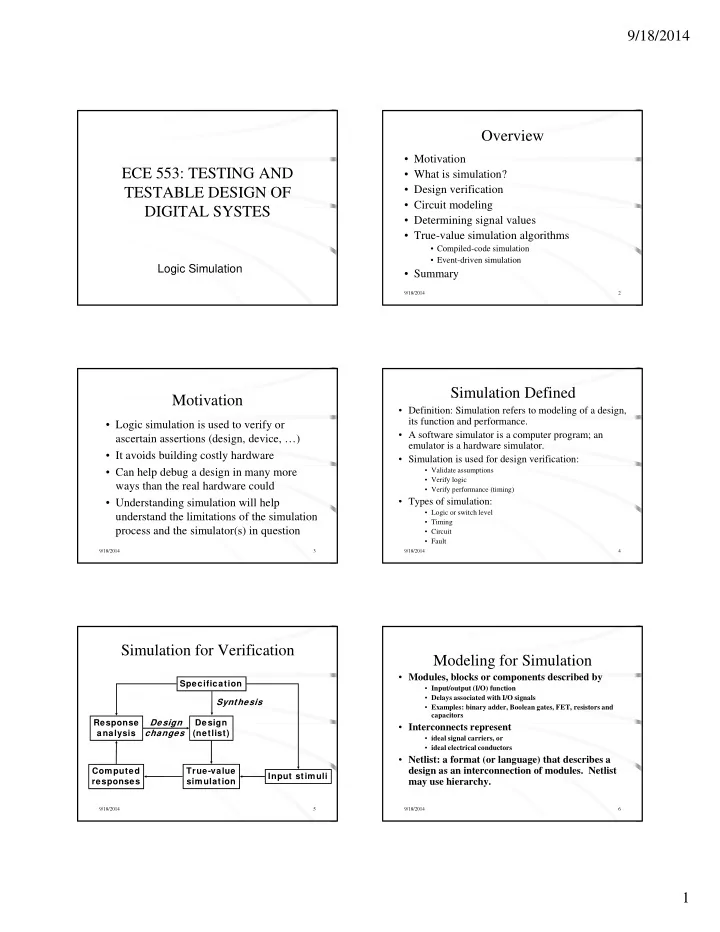

9/18/2014 Overview • Motivation ECE 553: TESTING AND • What is simulation? • Design verification TESTABLE DESIGN OF • Circuit modeling Circuit modeling DIGITAL SYSTES DIGITAL SYSTES • Determining signal values • True-value simulation algorithms • Compiled-code simulation • Event-driven simulation Logic Simulation • Summary 9/18/2014 2 Simulation Defined Motivation • Definition: Simulation refers to modeling of a design, its function and performance. • Logic simulation is used to verify or • A software simulator is a computer program; an ascertain assertions (design, device, …) emulator is a hardware simulator. • It avoids building costly hardware • Simulation is used for design verification: • Can help debug a design in many more • Validate assumptions • Verify logic ways than the real hardware could • Verify performance (timing) • Types of simulation: • Understanding simulation will help • Logic or switch level understand the limitations of the simulation • Timing process and the simulator(s) in question • Circuit • Fault 9/18/2014 3 9/18/2014 4 Simulation for Verification Modeling for Simulation • Modules, blocks or components described by Specification • Input/output (I/O) function • Delays associated with I/O signals Synthesis • Examples: binary adder, Boolean gates, FET, resistors and capacitors Response Response Design Design Design Design • Interconnects represent I analysis changes (netlist) • ideal signal carriers, or • ideal electrical conductors • Netlist: a format (or language) that describes a design as an interconnection of modules. Netlist Computed True-value Input stimuli may use hierarchy. responses simulation 9/18/2014 5 9/18/2014 6 1
9/18/2014 Options for Inertial Delay Logic Model of MOS Circuit (simulation of a NAND gate) Transient V DD pMOS FETs a Inputs region a D a c D c b a b D b C a c c (CMOS) C c C c b b D a and D b are Logic simulation c (zero delay) C b interconnect or nMOS FETs propagation delays c (unit delay) rise=5, fall=3 c (multiple delay) D c is inertial delay C a , C b and C c are of gate Unknow n (X) c (minmax delay) min =2, max =5 parasitic capacitances 0 5 Time units 9/18/2014 7 9/18/2014 8 Determining Gate Values Signal States • Two-states (0, 1) can be used for purely • Use of software logic primitives such as combinational logic with zero-delay. AND, OR, NOT instructions • Three-states (0, 1, X) are essential for timing • Search the truth table hazards and for sequential logic initialization. • Four-states (0, 1, X, Z) are essential for MOS • Use cubes and cube intersection rules for devices See example below devices. See example below. processing i • Analog signals are used for exact timing of digital • Use of X value and its processing logic and for analog circuits. – Example: x value simulation, problems associated with it, possible fixes and conservative Z (hold previous value) processing 0 0 9/18/2014 9 9/18/2014 10 True-Value Simulation Algorithms Compiled-Code Algorithm • Compiled-code simulation • Step 1: Levelize combinational logic and encode in a • Applicable to zero-delay combinational logic compilable programming language • Also used for cycle-accurate synchronous sequential circuits for logic verification • Step 2: Initialize internal state variables (flip-flops) • Efficient for highly active circuits, but inefficient for low-activity circuits • Step 3: For each input vector St 3 F h i t t • High-level (e.g., C language) models can be used Hi h l l ( C l ) d l b d • Event-driven simulation – Set primary input variables • Only gates or modules with input events are evaluated ( event means a – Repeat (until steady-state or max. iterations) signal change ) • Execute compiled code • Delays can be accurately simulated for timing verification – Report or save computed variables • Efficient for low-activity circuits • Can be extended for fault simulation 9/18/2014 11 9/18/2014 12 2
9/18/2014 Time Wheel (Circular Stack) Event-Driven Algorithm (Example) Scheduled Activity events list max a =1 e =1 Current t = 0 c = 0 d, e 2 time t=0 c =1 0 pointer Event link-list 1 g =1 1 2 2 2 d = 1, e = 0 f, g 2 d = 0 d = 0 Time stack 3 3 4 f =0 b =1 4 g = 0 4 5 5 g 6 6 f = 1 g 7 0 4 8 Time, t 7 8 g = 1 9/18/2014 13 9/18/2014 14 Efficiency of Event-driven Summary Simulator • Logic or true-value simulators are essential tools for • Simulates events (value changes) only design verification. • Speed up over compiled-code can be ten times • Verification vectors and expected responses are or more; in large logic circuits about 0.1 to generated (often manually) from specifications. 10% gates become active for an input change 10% gates become active for an input change • A logic simulator can be implemented using either A l i i l b i l d i i h compiled-code or event-driven method. • Per vector complexity of a logic simulator is Steady 0 Large logic Steady 0 approximately linear in circuit size. block w ithout (no event) activity 0 to 1 event • Modeling level determines the evaluation procedures used in the simulator. 9/18/2014 15 9/18/2014 16 3
Recommend
More recommend